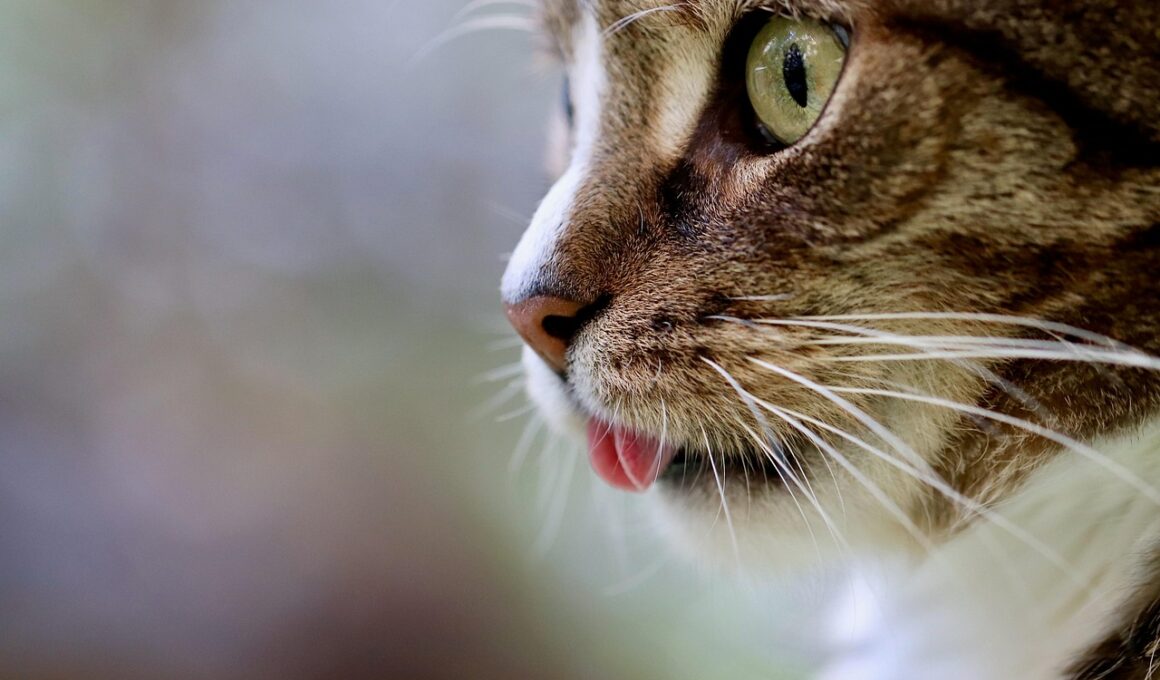How a Predictable Environment Supports Cat Social Development
Creating a predictable environment is crucial for fostering social development in cats. When cats are introduced to a stable routine, it helps alleviate anxiety and uncertainty. For instance, a consistent feeding schedule reassures cats that they will receive food at specific times, which nurtures their trust in their environment. This trust is key for building social interactions. Moreover, regular playtimes encourage healthy behavior, making the feline more approachable. The predictability of human actions can significantly ease a cat’s fear and encourage engagement. When cats feel secure, they are more likely to explore their surroundings and approach humans or other pets. The absence of unpredictability makes cats feel more comfortable, which is advantageous for socialization. Furthermore, it’s beneficial to integrate familiar toys and objects into their routine. Predictable environments can stimulate cats’ senses, enhancing their interest in interactive play and social interactions. Gradually, this leads to more confident creatures who can develop strong bonds with human caregivers. Through predictability, cats learn to anticipate and engage, ultimately improving their overall well-being and adaptability in social settings.
Besides routine, consistent interactions with owners significantly shape a cat’s social aptitude. Engaging with cats daily, through gentle petting or playing games like “catch the string,” allows them to understand human behavior better. Cats thrive on repetition, and they increasingly recognize and respond positively to their owners’ voice and actions. For example, if a cat receives a treat after successfully playing fetch, they associate the game with positive experiences. This rewards-based learning is pivotal in enhancing their comfort levels around humans. Additionally, incorporating social activities with other cats can also facilitate socialization. Owner-supervised playdates can expose cats to different behaviors, helping them learn to interact with their peers effectively. This exposure creates a safety net where cats can express themselves without fear of negative repercussions. It’s important to monitor these interactions to prevent overwhelming a shy cat. If introduced correctly, these social settings can reduce fear and foster friendliness. The combination of owner interaction and controlled play with peers creates well-adjusted cats who possess social skills conducive to harmony within a multi-pet household.
The Importance of Environmental Consistency
Environmental consistency remains a significant factor in a cat’s socialization process. When a cat’s surroundings change frequently, they may become stressed or insecure. Keeping their personal space, like litter boxes and beds, in familiar locations helps stabilize their habits. Cats are creatures of habit, and disruptions in their environment can lead to behavioral issues such as aggression or withdrawal. Consistent environments allow cats to explore their surroundings with confidence. Alongside maintaining consistent locations of their belongings, keeping the noise level predictable is also essential. Loud or unexpected sounds may provoke anxiety, causing them to retreat. Establishing a calm atmosphere allows cats to thrive. Therefore, owners should be mindful of creating a peaceful living space. Additionally, using products like pheromone diffusers can help mitigate stress in a dynamic home environment. These help mimic the natural scents that make cats feel safe and secure. As cats acclimate to their steady environment, they build stronger social connections over time. Ultimately, consistent environments not only foster better behavior but also promote deeper bonds between the cat and its owner.
Playtime routines significantly contribute to social skill development in cats as well. Scheduled playtime appeals to a cat’s natural instincts, allowing them to engage their predatory behaviors in a safe manner. Toys that mimic prey, like feather wands or laser pointers, encourage cats to hone their hunting skills. Engaging in play fosters the bond between cats and their humans. Regular interaction during these play sessions helps cats associate fun with human companionship, boosting their confidence. When a cat perceives their owner as a participant in their play and happiness, it enhances their willingness to socialize. Furthermore, the routines can also include gentle teases that stimulate their curiosity. Owners should vary the types of play to maintain interest and challenge their cats. A diverse range of interaction styles can keep cats engaged for an extended period. Regular play helps them learn to control their actions while engaging with their owners or other pets. By continuously engaging in playful routines, cats not only stay physically fit but also socially adept. Building a fun and interactive routine helps ease cats into a balanced social life over time.
Adaptation to New Experiences
Incorporating gradually new experiences within their routines encourages cats to evolve socially. Introducing changes in a controlled manner can prevent overwhelming them, allowing for smoother transitions. For instance, if a new pet is brought into the home, slow introductions help cats adjust without feeling threatened. Giving them ample time to adapt to the new presence enables them to assess the situation at their own pace. Over time, cats may become accepting of new situations or beings in their space. A gradual approach should be applied in all forms of enrichment, including novel toys or vacation visits to new environments. By allowing cats to explore new stimuli within their established routines, they can learn acceptable reactions. Over time, consistent exposure reassures them about their surroundings and the presence of consistent humans. Additionally, transitioning to challenging environments like veterinary clinics or grooming salons should also be introduced gently. Preparing a cat for new adventures can reduce anxiety and promote good behavior. Successful adaptation fosters a confident demeanor in cats which encourages healthy social behaviors. Thus intentional gradual exposure allows for positive experiences that shape a well-adjusted social feline in all aspects.
Moreover, maintaining a nurturing atmosphere that incorporates routine and consistency improves cats’ response to changes. Positive reinforcement plays a crucial role in teaching appropriate behaviors, especially when adapting to social settings. For example, if a cat remains calm during a visit to the vet, owners should reward them with treats or affection. This positive feedback loop can help create better associations with unusual or intimidating scenarios. Implementing such practices can encourage cats to seek comfort in their human companions when afraid. Owners can also employ training techniques to further enhance comfort levels. Basic commands or clicker training can significantly help cats feel more secure in their routines. The repeated sessions allow cats to comprehend and anticipate their owners’ expectations. This anticipation builds a bridge of trust that facilitates open communication between cats and their humans. Emphasizing understanding and adaptability further forms a strong bond. Therefore, relying on consistency in both the environment and interactions enhances the overall social well-being of the cat. By ensuring a nurturing atmosphere, many positive changes can be expected in a cat’s behavior and social development.
Conclusion: The Path to Stronger Social Bonds
In conclusion, promoting a predictable environment and routine is vital for any cat’s socialization process. Through a well-structured daily life with consistent interactions, cats learn to navigate their surroundings confidently. This foundational aspect helps them relate positively to humans and fellow animals. As trust and comfort develop, cats become more receptive to social opportunities, enabling them to thrive in various situations. Owners who prioritize and maintain these routines can significantly contribute to their pet’s happiness. The result is a cat that not only enjoys their interactions but also becomes a well-adjusted member of a multi-pet household. Routines offer mental stimulation and clarity, making it easier for cats to feel grounded. Over time, the journey towards stronger social bonds proves beneficial to both cats and their owners, ensuring a harmonious living environment. Embracing predictable practices allows pet owners to foster relationships built on reliability and affection. Implementing routines reinforces stability in a cat’s chaotic world. Ultimately, a predictable approach lays the groundwork for a social feline, leading to improved feline behavior and strong bonds that enrich lives.
It is essential to remember that each cat is unique and may adapt to routines differently. While some cats thrive in structured environments, others may require gradual adjustments to feel secure. Respecting a cat’s individual temperament allows owners to tailor routines that meet specific needs. Regularly observing a cat’s body language and behavior can help identify their comfort zones. By doing so, owners can respond effectively to their cats’ emotional states. Encouraging social development in cats is a journey that involves trial and error. The process requires patience and persistence as some individuals may take longer to adjust. Additionally, it’s crucial to offer encouragement during times of distress, creating safe spaces for them to retreat. Engaging with them patiently during these moments can alleviate anxiety, promoting a healthier relationship with their environment. Ultimately, the goal should not only be socialization but developing mutual trust and affection. Creating a welcoming home and predictable interactions can significantly enhance a cat’s quality of life. Emphasizing individuality while fostering social skills leads to well-rounded and happy cats that bring joy and companionship to their owners.


